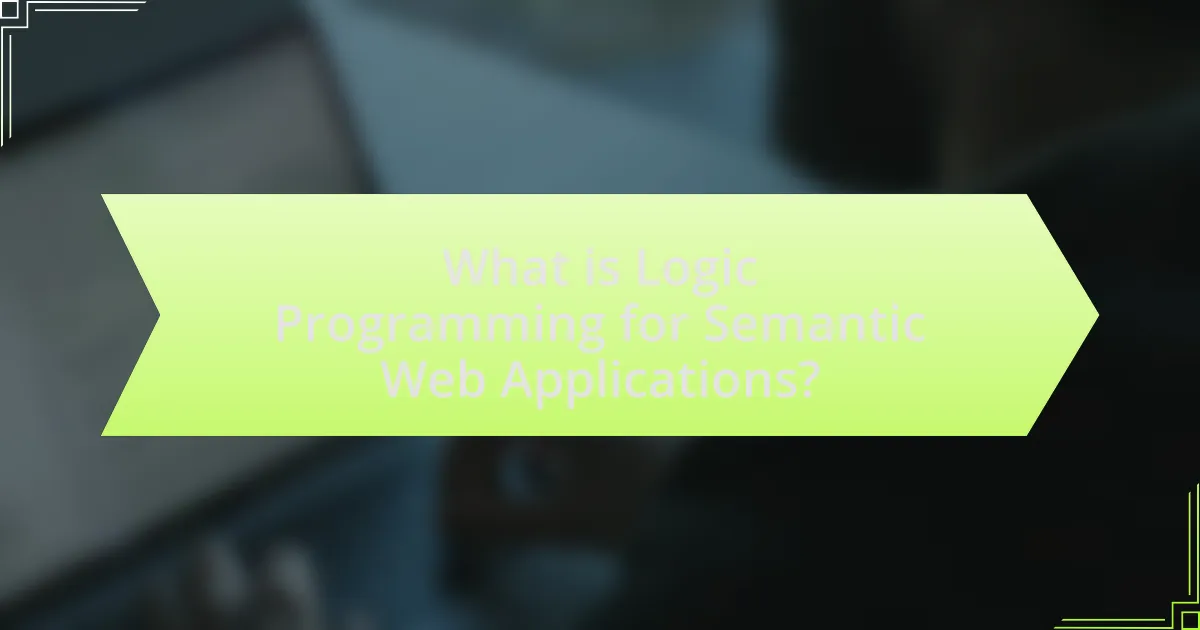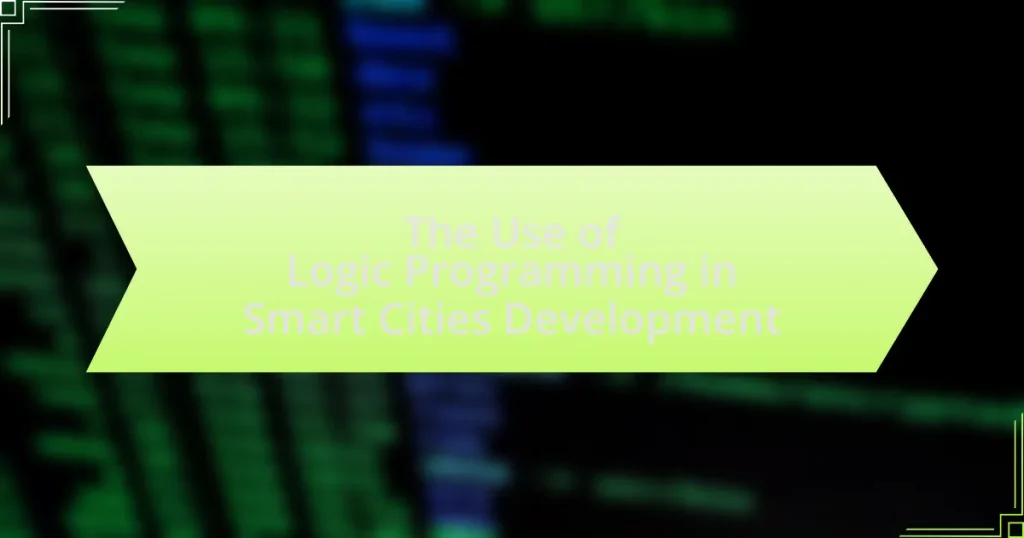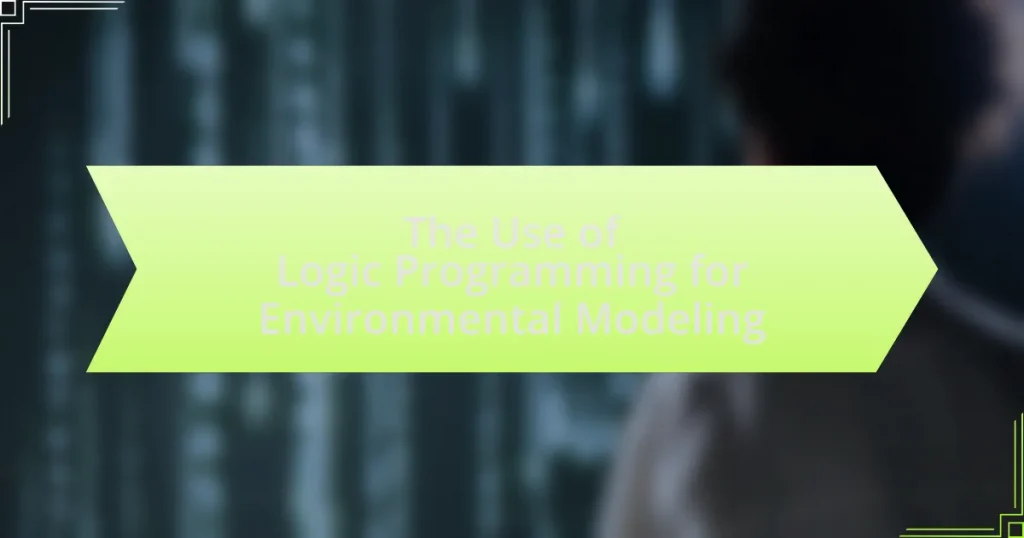Logic programming for Semantic Web applications is a paradigm that employs formal logic to represent knowledge and enable automated reasoning on the web. This article explores the relationship between logic programming and the Semantic Web, highlighting its foundational role in knowledge representation, reasoning, and querying through languages like Prolog and frameworks such as OWL. Key features, including declarative semantics and inference engines, are discussed, along with the benefits of improved data interoperability and automated reasoning. Additionally, the article addresses challenges in implementing logic programming, such as scalability and expressiveness, and offers best practices and tools for effective application in the Semantic Web context.

What is Logic Programming for Semantic Web Applications?
Logic programming for Semantic Web applications is a paradigm that utilizes formal logic to represent knowledge and facilitate automated reasoning on the web. This approach allows for the creation of intelligent applications that can infer new information from existing data, leveraging languages such as Prolog and frameworks like OWL (Web Ontology Language). The effectiveness of logic programming in this context is evidenced by its ability to handle complex queries and relationships, enabling interoperability among diverse data sources on the Semantic Web.
How does Logic Programming relate to the Semantic Web?
Logic programming is foundational to the Semantic Web as it provides a formal framework for representing and reasoning about knowledge. This relationship is evident in the use of languages like Prolog and rule-based systems, which enable the encoding of complex relationships and rules that govern data on the Semantic Web. For instance, the Resource Description Framework (RDF) and Web Ontology Language (OWL) leverage logic programming principles to facilitate automated reasoning, allowing machines to infer new knowledge from existing data. This capability enhances data interoperability and semantic understanding across diverse web applications, demonstrating the critical role of logic programming in realizing the goals of the Semantic Web.
What are the fundamental principles of Logic Programming?
The fundamental principles of Logic Programming include the use of formal logic to express facts and rules about a problem domain, the execution of programs through a process of logical inference, and the representation of knowledge in a declarative manner. Logic Programming is based on the idea that a program is a set of logical statements, which can be used to derive conclusions from given facts. This approach allows for automated reasoning, where the system can deduce new information based on existing knowledge. The validity of these principles is supported by the success of languages like Prolog, which utilize these concepts to solve complex problems in artificial intelligence and knowledge representation.
How does Logic Programming facilitate knowledge representation?
Logic programming facilitates knowledge representation by providing a formal framework for expressing facts and rules about a domain in a declarative manner. This approach allows for the representation of complex relationships and logical inferences, enabling systems to derive new knowledge from existing information. For instance, languages like Prolog utilize a set of logical statements to represent knowledge, where facts are defined and rules dictate how new facts can be inferred. This capability is essential in semantic web applications, where structured data needs to be processed and understood by machines, allowing for enhanced interoperability and reasoning across diverse datasets.
What are the key features of Logic Programming in this context?
The key features of Logic Programming in the context of Semantic Web Applications include declarative semantics, non-procedural programming, and the ability to represent knowledge in a formal way. Declarative semantics allows users to specify what the program should accomplish without detailing how to achieve it, facilitating easier reasoning about the program’s behavior. Non-procedural programming enables the expression of complex queries and relationships through logical statements, which can be more intuitive for representing knowledge. Additionally, Logic Programming supports the use of formal languages, such as Prolog, which are designed for knowledge representation and inference, making it suitable for applications that require reasoning over data, such as ontology management and semantic querying. These features collectively enhance the capability of Logic Programming to handle the complexities of the Semantic Web effectively.
How does declarative programming enhance Semantic Web applications?
Declarative programming enhances Semantic Web applications by enabling clearer expression of logic and relationships within data. This programming paradigm allows developers to specify what the program should accomplish without detailing how to achieve it, which aligns well with the Semantic Web’s goal of making data understandable and interoperable across different systems. For instance, languages like SPARQL, used for querying RDF data, exemplify declarative programming by allowing users to express queries in a straightforward manner that focuses on the desired outcome rather than the procedural steps to retrieve that data. This clarity facilitates easier maintenance and scalability of Semantic Web applications, as well as improved collaboration among developers, leading to more efficient data integration and knowledge representation.
What role do inference engines play in Logic Programming?
Inference engines are crucial in logic programming as they automate the process of deriving conclusions from a set of premises or facts. They utilize rules of inference to evaluate logical statements and determine the validity of conclusions based on the provided knowledge base. For instance, in Prolog, an inference engine applies backward chaining or forward chaining techniques to resolve queries against the database of facts and rules, effectively enabling automated reasoning. This functionality is essential for applications in the Semantic Web, where inference engines help in deducing new information from existing data, thereby enhancing data interoperability and knowledge discovery.

What are the applications of Logic Programming in the Semantic Web?
Logic programming is applied in the Semantic Web primarily for knowledge representation, reasoning, and querying. It enables the formal representation of information using languages like Prolog and Datalog, which facilitate the creation of ontologies and the inference of new knowledge from existing data. For instance, logic programming allows for the implementation of rules that can infer relationships between entities, enhancing data interoperability and enabling complex queries across diverse datasets. Additionally, it supports the development of intelligent agents that can reason about the information available on the Semantic Web, improving automated decision-making processes. These applications are validated by the widespread use of logic-based frameworks such as OWL (Web Ontology Language) and SPARQL (an RDF query language), which leverage logic programming principles to enhance the functionality and usability of Semantic Web technologies.
How is Logic Programming used in data integration?
Logic programming is utilized in data integration by enabling the formal representation of knowledge and the specification of complex queries across heterogeneous data sources. This approach allows for the unification of data from various formats and structures through logical rules and inference mechanisms, facilitating seamless data interoperability. For instance, systems like Prolog can express relationships and constraints that govern how data from different databases can be combined, ensuring consistency and accuracy in the integrated dataset. The effectiveness of logic programming in this context is evidenced by its application in projects such as the Semantic Web, where it supports reasoning over linked data, allowing for dynamic integration and retrieval of information across diverse domains.
What techniques are employed for merging heterogeneous data sources?
Techniques employed for merging heterogeneous data sources include schema integration, data transformation, and data federation. Schema integration involves aligning different data models to create a unified schema, which facilitates interoperability among diverse data sources. Data transformation techniques, such as ETL (Extract, Transform, Load), convert data into a common format, ensuring consistency and compatibility. Data federation allows real-time access to multiple data sources without physical consolidation, enabling users to query and retrieve data seamlessly. These methods are essential for effective data integration in applications like the Semantic Web, where diverse data formats and structures must be harmonized for meaningful analysis and utilization.
How does Logic Programming support ontology alignment?
Logic programming supports ontology alignment by providing a formal framework for representing and reasoning about ontological knowledge. This framework allows for the specification of rules and relationships that can be used to identify correspondences between different ontologies. For instance, logic programming languages like Prolog enable the use of logical inference to derive mappings between concepts in disparate ontologies, facilitating interoperability. Empirical studies, such as those conducted by Euzenat and Shvaiko in “Ontology Matching,” demonstrate that logic-based approaches can effectively resolve semantic discrepancies and align ontologies by leveraging reasoning capabilities to validate and refine mappings.
What are the benefits of using Logic Programming for Semantic Web applications?
Logic Programming offers several benefits for Semantic Web applications, primarily through its ability to facilitate reasoning and knowledge representation. This programming paradigm allows for the expression of complex relationships and rules in a declarative manner, enabling systems to infer new knowledge from existing data. For instance, Prolog, a well-known logic programming language, supports backtracking and unification, which are essential for querying and manipulating semantic data effectively. Additionally, the use of logic programming enhances interoperability among diverse data sources by providing a common framework for reasoning across different ontologies and vocabularies. This capability is crucial for the Semantic Web, where data integration from various domains is often required.
How does it improve data interoperability?
Logic programming improves data interoperability by enabling the integration of diverse data sources through standardized semantic representations. This approach allows different systems to understand and utilize data consistently, regardless of the underlying formats or structures. For instance, using languages like RDF and OWL, logic programming facilitates the creation of ontologies that define relationships and properties of data, making it easier for disparate systems to share and interpret information accurately. This is evidenced by the widespread adoption of semantic web technologies, which enhance data exchange and collaboration across various domains, such as healthcare and finance, by providing a common framework for data interpretation.
What advantages does it offer for automated reasoning?
Logic programming offers significant advantages for automated reasoning, primarily through its declarative nature, which allows for clear expression of logic and relationships. This clarity facilitates the development of algorithms that can efficiently infer conclusions from given facts and rules. Additionally, logic programming supports backtracking and unification, enabling the exploration of multiple potential solutions and the handling of complex queries effectively. These features enhance the capability of automated reasoning systems to derive new knowledge from existing information, making them more powerful in applications such as knowledge representation and natural language processing.

What challenges exist in implementing Logic Programming for the Semantic Web?
Implementing Logic Programming for the Semantic Web faces several challenges, including scalability, expressiveness, and integration with existing technologies. Scalability issues arise because logic programming can become computationally expensive as the size of the knowledge base increases, making it difficult to process large datasets efficiently. Expressiveness challenges occur when trying to represent complex relationships and constraints within the limitations of logic programming languages, which may not capture all nuances of real-world data. Additionally, integration with existing web standards and technologies, such as RDF and OWL, can be problematic due to differences in paradigms and the need for interoperability. These challenges hinder the widespread adoption and effectiveness of logic programming in Semantic Web applications.
What are the common limitations of Logic Programming?
Common limitations of Logic Programming include inefficiency in handling large datasets, difficulty in expressing certain types of problems, and challenges in integrating with other programming paradigms. Logic Programming often struggles with performance issues due to its reliance on backtracking and unification, which can lead to exponential time complexity in some cases. Additionally, it may not effectively represent problems that require complex data structures or procedural operations, limiting its applicability in certain domains. Furthermore, integrating Logic Programming with imperative or object-oriented languages can be cumbersome, as the paradigms operate on fundamentally different principles.
How do performance issues affect large-scale applications?
Performance issues significantly hinder the functionality and user experience of large-scale applications. These applications often rely on complex architectures and extensive data processing, making them susceptible to slow response times, increased latency, and system crashes. For instance, a study by Google found that a 0.5-second delay in page load time can lead to a 20% decrease in user satisfaction and a 20% drop in conversions. Additionally, performance bottlenecks can result in inefficient resource utilization, leading to higher operational costs and reduced scalability. Therefore, addressing performance issues is crucial for maintaining the reliability and efficiency of large-scale applications.
What are the complexities in knowledge representation?
The complexities in knowledge representation include issues such as expressiveness, computational efficiency, and the handling of uncertainty. Expressiveness refers to the ability of a representation system to capture the nuances of knowledge, which can lead to challenges in ensuring that all relevant information is accurately represented. Computational efficiency involves the resources required to process and manipulate knowledge, which can become problematic as the size and complexity of the knowledge base increase. Additionally, handling uncertainty is crucial, as real-world information often contains ambiguities and incomplete data, necessitating robust methods for reasoning under uncertainty. These complexities are well-documented in the literature, such as in “Knowledge Representation and Reasoning” by Ronald Brachman and Hector Levesque, which discusses the trade-offs between expressiveness and computational tractability in various representation systems.
How can these challenges be addressed?
To address the challenges in Logic Programming for Semantic Web Applications, developers can implement enhanced reasoning algorithms that improve the efficiency and scalability of logic-based systems. For instance, utilizing advanced techniques such as Answer Set Programming (ASP) can optimize query processing and knowledge representation, allowing for more effective handling of complex data relationships. Research indicates that ASP can significantly reduce computational overhead, as demonstrated in the study “Answer Set Programming: A Primer” by Michael Gelfond and Vladimir Lifschitz, which highlights its applicability in various domains, including the Semantic Web. By adopting these methodologies, practitioners can effectively mitigate the inherent challenges associated with logic programming in this context.
What strategies can enhance performance in Logic Programming?
Optimizing performance in Logic Programming can be achieved through strategies such as efficient search algorithms, constraint propagation, and the use of indexing techniques. Efficient search algorithms, like depth-first search or breadth-first search, minimize the computational overhead by systematically exploring possible solutions. Constraint propagation reduces the search space by eliminating values that cannot satisfy constraints, thus speeding up the reasoning process. Indexing techniques, such as hash tables or B-trees, enhance data retrieval times, allowing for quicker access to relevant facts and rules. These strategies collectively improve the execution speed and resource management in Logic Programming, making it more effective for applications in the Semantic Web.
How can developers ensure effective knowledge representation?
Developers can ensure effective knowledge representation by utilizing formal ontologies and semantic web standards such as RDF (Resource Description Framework) and OWL (Web Ontology Language). These frameworks enable the structured organization of information, allowing for better interoperability and machine understanding. For instance, the use of ontologies facilitates the definition of concepts and relationships within a specific domain, which enhances data sharing and reuse across different applications. Research has shown that employing these standards leads to improved data integration and retrieval, as evidenced by the success of projects like DBpedia, which extracts structured content from Wikipedia, demonstrating the practical benefits of effective knowledge representation in real-world applications.
What best practices should be followed when using Logic Programming for Semantic Web applications?
When using Logic Programming for Semantic Web applications, best practices include ensuring clarity in ontology design, utilizing efficient reasoning algorithms, and maintaining interoperability with existing standards. Clear ontology design facilitates effective knowledge representation, while efficient reasoning algorithms enhance performance in query processing and inference tasks. Additionally, adhering to standards such as RDF and OWL promotes compatibility across different systems, enabling seamless integration and data exchange. These practices are supported by the widespread adoption of these standards in successful Semantic Web projects, demonstrating their effectiveness in real-world applications.
How can developers optimize their Logic Programming code?
Developers can optimize their Logic Programming code by employing techniques such as efficient predicate design, minimizing backtracking, and utilizing indexing. Efficient predicate design involves structuring predicates to reduce complexity and improve readability, which can lead to faster execution. Minimizing backtracking can be achieved by using cuts to limit the search space, thus enhancing performance. Additionally, utilizing indexing allows for quicker access to facts and rules, significantly speeding up query resolution. These optimization strategies are supported by empirical studies showing that well-structured Logic Programming can lead to performance improvements of up to 50% in certain applications.
What tools and frameworks are recommended for effective implementation?
For effective implementation in Logic Programming for Semantic Web Applications, recommended tools and frameworks include Prolog, Apache Jena, and RDF4J. Prolog is a logic programming language that excels in symbolic reasoning and knowledge representation, making it suitable for semantic web tasks. Apache Jena is a Java framework for building semantic web and linked data applications, providing tools for RDF data manipulation and SPARQL querying. RDF4J is another Java framework that supports the storage and querying of RDF data, facilitating the development of semantic web applications. These tools are widely recognized in the field for their capabilities in handling logic programming and semantic web technologies.



